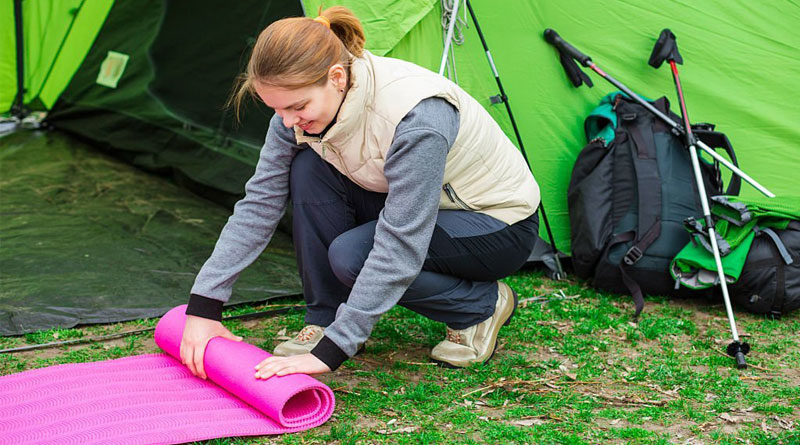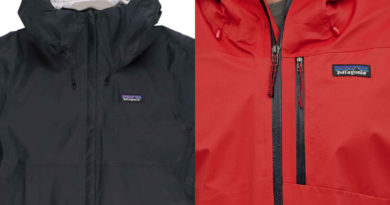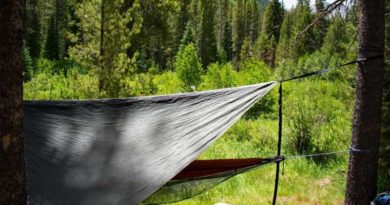Can a Yoga Mat be used as a Sleeping Pad?
When camping, a sleeping pad performs the most crucial function of keeping you warm and insulated by lifting you from the ground. But there can be several reasons that you would want to use something else as a substitute for a sleeping pad. You may not have enough budget, you may not have the time to get a sleeping pad, or you may just be curious.
One of the substitutes many people get curious about is a yoga mat. This is because there are some similarities between a yoga mat and a sleeping pad, especially a closed-cell foam sleeping pad. After all, a sleeping pad is also a mat that you lie down on in your sleeping bag.
Short answer: No! A yoga mat is not a substitute for a sleeping pad. Let’s see why…
What are Yoga Mats for?
Yoga mats are for practicing yoga. They provide cushioning to the person doing yoga so that they don’t feel uncomfortable because of the hard ground. The material of a yoga mat also prevents slipping and sliding so that the person doing yoga doesn’t injure themselves during different yoga poses.
What are Sleeping Pads for?
Sleeping pads are used for sleeping in the outdoors during camping. They provide comfort by keeping off the hard uneven ground. Sleeping pads also provide insulation to keep you warm and prevent body heat to escape to the ground beneath or through wind under a hammock. Among the functions of a sleeping pad, insulation is a primary function while comfort is a secondary function.
Why you Shouldn’t use a Yoga Mat
A yoga mat is not a good substitute for a traditional camping pad as mentioned above. Here are a few reasons why you shouldn’t use a yoga mat:
No Comfort
Yoga mats are designed to provide traction during yoga. They are not made for long-term comfort during sleeping. Yoga mats are thin and don’t have a lot of cushioning. If you sleep on a yoga mat you will feel the hard ground beneath you, especially, if there are rocks and roots under you. It will be even more problematic if you are a side sleeper. Come to think of it, yoga mats are made for you to be active on them, not rest on them.
Lack of Insulation
Sleeping pads use trapped air as an insulator. They are designed in a way to trap air. Sleeping pads also make use of reflective surfaces to retain body heat. Yoga mats are thin and are not designed to trap air in them nor do they have reflective surfaces.
If you decide to use a yoga mat instead of a sleeping pad then you should have some other insulation options as well to keep you warm throughout the night. A yoga mat doesn’t provide any insulation. Its closed rubber material makes it a poor insulator.
More Weight
Many sleeping pads weigh less than a pound and they are made extremely light because they are meant to be packed and taken on long walks. Although yoga mats are made of a variety of different materials, they are primarily made of rubber.
The rubber material of a yoga mat is not as lightweight as foam used in sleeping pads. Yoga mats usually weigh 4 to 5 times more than a sleeping pad. Thicker sleeping pads weigh even more. Some yoga mats do come as lightweight travel pads, but they still weigh somewhere around 3lbs which is considered heavy in backpacking terms.
While it is uncommon to find a sleeping pad that weighs more than 2lbs, it is also uncommon to find a yoga mat that weighs less than 2lbs.
Not Compact
Sleeping pads are made to take up little space in your backpack. A closed-cell foam pad takes up the most space in a backpack but it can still be packed into a small roll. Inflatable pads such as air pads and self-inflating pads can be packed extremely tight and small after letting all the air out.
There are no such options in a yoga mat. Its rubber material can only be packed into a huge roll. You will have problems putting that roll in your backpack and carrying it around. Thicker yoga mats are even harder to pack.
Thick Yoga Pads
Thicker 1-inch yoga pads are better than regular yoga pads for sleeping. They provide some amount of comfort but they are even heavier and more difficult to pack. They don’t have a definite R-value so it’s hard to say how much insulation they would provide but you shouldn’t expect much. However, a thick yoga pad may work fine in warm weather if you can pack and walk with it.
Viable Alternatives to a Sleeping Pad
If for some reason you can’t arrange a sleeping pad for a camping trip, you can use the following options as substitutes for a sleeping pad.
- Sleeping cot
- Air mattress
- Lots of blankets with a thick sleeping bag
- Hammock
- A thick pile of leaves
For comfort, anything that keeps you off the ground enough will work in which case a thick yoga mat is viable. But keeping you comfortable doesn’t necessarily mean keeping you warm. To stay warm, you would need some thick insulation. But the work of a sleeping pad can only be done by a sleeping pad. You would have to do a lot to keep yourself comfortable and warm if you don’t have a sleeping pad.
Final Thoughts
Yoga mats look similar to sleeping pads, especially, closed-cell foam sleeping pads. This apparent similarity leads many people to believe that yoga mats can work as a substitute for a sleeping pad. It is only in the middle of the night when they wake up shivering that they realize how wrong they were.
Yoga mats are functionally opposite to sleeping pads. They are heavy, they have a large pack size, and they provide little to no insulation. Some of them don’t even provide any comfort. The only way yoga mats are similar to sleeping pads is that you can lie down on both of them.




